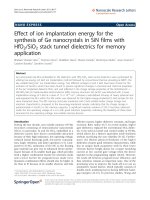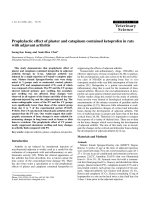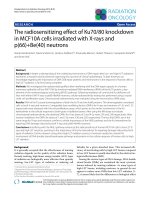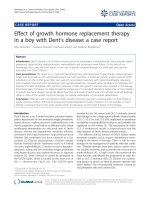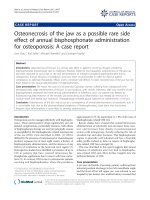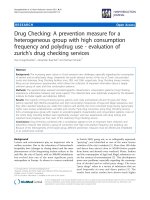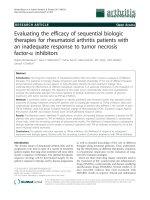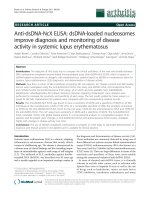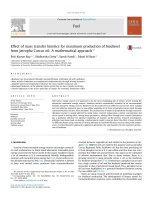Pore size effect of 1,3,6,8-tetrakis(4-carboxyphenyl)pyrene-based metal-organic frameworks for enhanced SF6 adsorption with high selectivity
Bạn đang xem bản rút gọn của tài liệu. Xem và tải ngay bản đầy đủ của tài liệu tại đây (2.41 MB, 9 trang )
Microporous and Mesoporous Materials 343 (2022) 112161
Contents lists available at ScienceDirect
Microporous and Mesoporous Materials
journal homepage: www.elsevier.com/locate/micromeso
Pore size effect of 1,3,6,8-tetrakis(4-carboxyphenyl)pyrene-based
metal-organic frameworks for enhanced SF6 adsorption with
high selectivity
ă
ăm b, Daniel Hedbom a,
Michelle Åhl´en a, Francoise M. Amombo Noa b, Lars Ohrstr
o
Maria Strømme a, Ocean Cheung a, *
a
Division of Nanotechnology and Functional Materials, Department of Materials Science and Engineering, Uppsala University, ngstră
om Laboratory, Uppsala, SE-751
03, Box 35, Sweden
b
Chemistry and Biochemistry, Department of Chemistry and Chemical Engineering, Chalmers University of Technology, Gothenburg, SE-41296, Sweden
A R T I C L E I N F O
A B S T R A C T
Keywords:
Metal-organic frameworks
Greenhouse gas capture
Sulfur hexafluoride
TBAPy
Anthropogenic greenhouse gas emission poses as serious threat to our environment and it is therefore of utmost
importance that efficient systems are developed to mitigate these issues. SF6, in particular, has attracted more
attention in recent years due to its global warming potential which severely exceeds that of CO2. In this study we
present the SF6 sorption properties of four highly porous 1,3,6,8-tetrakis(4-carboxyphenyl)pyrene-based
(TBAPy4− ) metal-organic frameworks containing either ytterbium(III), thulium(III), cerium(III), or hafnium
(IV). These MOFs can be synthesized with high crystallinity in as little as 5 h and were found to have good SF6
uptakes due to their suitable pore size. The SF6 uptake of the Yb-TBAPy MOF reached 2.33 mmol g− 1 with high
Henry’s law SF6-over-N2 selectivity of ~80 at 1 bar and 293 K. The TBAPy-MOFs were also found to have good
chemical stability and good cyclic SF6 sorption stability with fast SF6 uptake. These TBAPy-MOFs possesses many
of the properties desired for an efficient SF6 sorbent and may be suitable sorbents for further development,
including sorbent processing for industrial applications.
1. Introduction
The effect of increased concentrations of greenhouse gases in the
atmosphere has been confidently linked to the observed climate change
and global warming in recent years. Of the typical greenhouse gases,
carbon dioxide (CO2) and methane (CH4) are perhaps the most wellknown as they are connected to our everyday lives - e.g. the combus
tion of fossil fuel, or animal farming. Other greenhouse gases, such as
sulfur hexafluoride (SF6), is less known at least in the mainstream media.
SF6 has excellent dielectric properties, it is non-toxic, and thermally
stable. This has made SF6 a popular choice in a number of applications
where these properties are desired, such as in high-voltage systems,
circuit breakers, and the semiconductor manufacturing industries. On
the other hand, the global warming potential of SF6 is over 22,000 times
higher than that of CO2 [1], which means that the emission of SF6 is also
a significant contributor to global warming. A number of technological
solutions have been employed to reduce the emission of SF6, these
include incineration, SF6 recirculation, plasma discharge, and radio
frequency discharge etc. However, the removal of SF6 from its point
sources through the use of solid-based adsorption processes has, in
recent years, garnered attention and has been proposed as a potentially
efficient alternative. Adsorption of SF6 would require a good adsorbent
and a number of potential microporous materials have been considered
as candidate sorbents, including zeolites [2,3], porous carbons [4,5], as
well as metal-organic frameworks (MOFs) [6,7]. A good adsorbent needs
to possess desirable properties, including high capture capacity, good
selectivity, low heats of adsorption for easy regeneration, high cycling
stability over a number of adsorption cycles and more. Metal-organic
frameworks, being a class of porous materials that are constructed
from organic linkers coordinating the metal centers, have interesting
constructions which allow them to possess enormous structural di
versity. Many properties of MOFs can be tailored such as pore size,
surface chemistry, flexibility, and stability [6,8]. The diverse structural
possibilities and chemistries allow MOFs to be considered as promising
functional materials for many applications, which include drug delivery,
catalysis, energy conversion, gas sensing, and luminescence-based
* Corresponding author.
E-mail address: (O. Cheung).
/>Received 23 March 2022; Received in revised form 3 August 2022; Accepted 4 August 2022
Available online 12 August 2022
1387-1811/© 2022 The Authors. Published by Elsevier Inc. This is an open access article under the CC BY license ( />
M. Åhl´en et al.
Microporous and Mesoporous Materials 343 (2022) 112161
sensing [9–14]. Tetratopic pyrene-based organic molecules have shown
to be interesting building blocks for the construction of novel MOF
structures [15]. Pyrene-based frameworks have successfully been pre
pared from various main group and transition metals, such as Mg(II)
[16–18], Zn(II) [19–22], Ni(II) [23], In(III) [24], Eu(III) [25], Zr(IV)
[26], Hf(IV) [27], and U(IV) [28,29], resulting in a large number of
MOFs with diverse structural features. Examples of such features can be
seen in many 1,3,6,8-tetrakis(4-carboxyphenyl)pyrene-based frame
works such as the 3D indium(II)- and cadmium(II)-based frameworks
ROD-7 [24] and ROD-8 [30]. Both ROD-7 and ROD-8 both exhibit
structures composed of infinite 1D ROD secondary building units (SBUs)
interconnected through the tetratopic pyrene ligands. Forming two
types of 1D channels with dimensions of 4.93 × 9.83 Å/6.82 × 8.96 Å
along the b-axis [24] and 8.5 × 9.5 Å/6.5 × 11.8 Å along the a-axis [30]
for ROD-7 and ROD-8, respectively. Both frameworks exhibited appre
ciable porosities – with Brunauer-Emmett-Teller (BET) surface areas
ranging from approximately 1189 m2 g− 1 for ROD-7 [24] to 369 m2 g− 1
for ROD-8 [30]. The CO2 uptake capacities of the frameworks were not
found to correlate to the specific surface areas of the MOFs, as ROD-8
displayed a higher CO2 adsorption capacity (1.8 mmol g− 1) [30] as
compared to ROD-7 (1.5 mmol g− 1) [31] at 298 K and 1 bar. Although
the authors did not provide an explanation for this phenomenon, it may
likely be related to the interplanar distance between the pyrene cores in
ROD-8 (4.35 Å [30]). The interplanar distance in ROD-8 is closer in
distance as compared to ROD-7 (7.12 Å [31]), resulting in an increased
interaction between the CO2 molecules and the pore surface. Similarly,
the europium-based ROD-MOF JXNU-5 shares some structural similar
ities to ROD-7 and ROD-8. The 3D framework possesses 1D channels
with apertures of 4.6 Å and 6.7 Å (as determined by nonlocal density
functional theory- NLDFT) but has a less symmetric structure due to the
inherently different rod-metal-SBU in JXNU-5. The framework was
found to have comparable BET surface area (406 m2 g− 1) and CO2 up
take capacity (1.55 mmol g− 1 at 298 K and 1 bar) to ROD-7 and ROD-8
despite the slight structural distortion [25]. The formation of framework
structures with large pores have also been successfully obtained in the
zirconium(IV)- and hafnium(IV)-based pyrene-based frameworks
NU-1000 [26,27]. Unlike the previously mentioned ROD-MOFs, Zr- and
Hf-NU-1000 exhibit both meso- (31 Å/29 Å) and micropores (12 Å and 8
Å/13 Å) [32] resulting in highly porous frameworks with BET surface
areas of 2320/1780 m2 g− 1 and a total pore volumes of 1.26/1.14 cm3
g− 1 (of which 43% constitutes the micropore volume in Zr-NU-1000)
[27,32]. Although the CO2 uptake capacity of Zr-NU-1000 (7.92 wt%)
[31] is comparable to that of ROD-8, it can be assumed that this phe
nomenon is due to the high porosity and not to an increased CO2-pore
surface interaction, as is evident by the low CO2 heat of adsorption on
Zr-NU-1000 [31]. The pore size of many 1,3,6,8-tetrakis(4-carboxy
phenyl)pyrene (TBAPy)-based frameworks has shown to be capable
for the sorption of small gaseous adsorbates, such as CO2 (3.3 Å [33])
and CH4 (3.8 Å [34]) [19,23,25,31,35], however the relatively large
crystallographic pore aperture (>4 Å) of structures such as ROD-7, -8,
JXNU-5, and NU-1000 may indicate that pyrene-based frameworks
could be promising for the capture of SF6 (5.5 Å [36]).
In this study, we tested four highly porous MOFs based on TBAPy4−
coordinated with different metals, namely ytterbium (Yb(III)), thulium
(Tm(III)), cerium (Ce(III)), and hafnium (Hf(IV)). These MOFs are
similar to other TBAPy-based MOFs previously reported in literature,
including ROD-7 [24], JXNU-5 [25], and Hf-NU-1000 [27]. The sorption
properties of these TBAPy-MOFs were examined and specifically the
possibility of using these MOFs as SF6 adsorbents are be discussed.
(C2H3O2)3⸱xH2O) were purchased from Sigma-Aldrich (USA). Ammo
nium cerium(IV) nitrate (Ce(NH4)2(NO3)6), N,N-dimethylformamide
(DMF) were obtained from VWR AB (Sweden) and 1,3,6,8-tetrakis(4carboxyphenyl)pyrene (H4TBAPy) was purchased from AmBeed Inc.
(Arlington, USA).
All solvents and chemicals were used as received without further
purification.
2.2. Experimental procedures
2.2.1. Synthesis of Yb-TBAPy
Yb(C2H3O2)3⸱4H2O (84.45 mg, 0.20 mmol) and H4TBAPy (136.54
mg, 0.20 mmol) were dissolved in 10 ml DMF. The mixture was trans
ferred to a Teflon-lined stainless-steel autoclave and heated in an oven to
200 ◦ C. After 48 h the autoclave was removed from the oven and
allowed to cool to ambient temperatures. The product was collected
using centrifugation at 3,800 rpm for 10 min, washed in DMF three
times, and dried in a ventilated oven at 70 ◦ C.
2.2.2. Synthesis of Tm-TBAPy
The synthesis of Tm-TBAPy was carried out in a similar manner to
Yb-TBAPy. Briefly, Tm(C2H3O2)3⸱xH2O (69.21 mg, 0.20 mmol) and
H4TBAPy (136.54 mg, 0.20 mmol) were dissolved in 10 ml DMF. The
mixture was heated in a Teflon-lined stainless-steel autoclave and left in
an oven at 200 ◦ C. After 48 h the autoclave was removed from the oven
and allowed to cool and the product was collected using centrifugation
at 3,800 rpm for 10 min, washed with DMF three times, and finally dried
in a ventilated oven at 70 ◦ C.
2.2.3. Synthesis of Hf-TBAPy
Hf-TBAPy was synthesized using different procedures than those
presented in literature for Hf-NU-1000 [27]. Briefly, a mixture of HfCl4
(128.12 mg, 0.40 mmol) and H4TBAPy (273.08 mg, 0.40 mmol) was
dissolved in 10 ml DMF. The mixture was heated in a Teflon-lined
stainless-steel autoclave at 200 ◦ C for 24 h, after which the cooled
product was collected by centrifugation at 3,8000 rpm for 10min,
washed with DMF three times, and dried in a ventilated oven at 70 ◦ C.
2.2.4. Synthesis of Ce-TBAPy
A mixture of Ce(NH4)2(NO3)6 (109.64 mg, 0.20 mmol) and H4TBAPy
(136.54 mg, 0.20 mmol) in 10 ml DMF was heated in a Teflon-lined
stainless-steel autoclave at 200 ◦ C. The mixture was left in the oven
for 5 h and the cooled product was thereafter collected by centrifugation
at 3,800 rpm for 10 min, washed with DMF three times, and dried in a
ventilated oven at 70 ◦ C.
2.3. Materials characterization
2. Experimental section
Powder X-ray diffractograms (PXRD) of the synthesized materials
were recorded on a Bruker D8 Advance TwinTwin diffractometer (Bre
men, Germany) using Cu Kα-radiation (λ = 1.5418 Å) and operated at
40 kV and 40 mA. PXRD data were collected within a 2θ-range of 5–50◦
using a step-size of 0.015◦ and a time-per-step of 0.4 s. Scanning electron
microscopy (SEM) images were obtained using a Zeiss Merlin Field
Emission Scanning Electron Microscope (Oberkochen, Germany) oper
ated at 1 kV and 50 pA. All samples were pre-sputtered using Ag/Pd
prior to imaging. Core-level XPS spectra were recorded on a ULVAC-PHI
II Scanning XPS Microprobe (Chanhassen, MN, US) using mono
chromatic Al Kα radiation and Ar+ ions as well as low-energy electrons
for charge neutralization. Obtained spectra were calibrated using the C
1s peak for adventitious carbon at 284.8 eV.
2.1. Materials
2.4. Gas sorption analysis
Hafnium(IV) chloride (HfCl4), Ytterbium(III) acetate tetrahydrate
(Yb(C2H3O2)3⸱4H2O),
and
Thulium
acetate
hydrate
(Tm
Equilibrium sorption isotherms were collected on a Micromeritics
ASAP2020 surface area analyzer (Norcross, GA, USA) on samples pre2
M. Åhl´en et al.
Microporous and Mesoporous Materials 343 (2022) 112161
degassed at 448 K for 3 h under dynamic vacuum (1 × 10− 4 Pa) using a
Micromeritics SmartVacPrep (Norcross, GA, USA). Langmuir specific
surface areas were calculated from nitrogen (N2) isotherms recorded at
liquid nitrogen temperatures (77 K) and the corresponding density
functional theory (DFT) pore size distributions were estimated from the
N2 isotherms using the slit pore mode for N2. CH4, CO2, N2, and SF6
equilibrium isotherms were recorded using a Micromeritics ASAP2020
surface area analyzer (Norcross, GA, USA) at 273–303 K using an
insulated dewar containing temperature adjusted/controlled water or
an ice-water slurry. Brunauer-Emmett Teller (BET) was calculated with
the recorded isotherm data using the BET surface identification (BETSI)
software provided by Adsorption and Advanced Materials Lab (AAML),
Department of Chemical Engineering & Biotechnology, University of
Cambridge, UK [37]. Gas selectivities for theoretical gas mixtures con
taining SF6/N2 (10:90), CO2/N2 (15:85), and CO2/CH4 (50:50) were
calculated using the Ideal Adsorption Solution Theory (IAST) [38] from
single component isotherms recorded at 273–303 K. The CH4, CO2, N2,
and SF6 isotherms were fitted using either the single- or dual-site
Langmuir model for the IAST calculations. Henry’s law selectivities (s
= KH, gas 1/KH, gas 2) for SF6/N2, CO2/N2, and CO2/CH4 were calculated
using the Henry’s law constants (KH, gas) obtained from single compo
nent isotherms collected at 273–303 K. Isosteric enthalpies (-ΔHads) of
SF6, CO2, and CH4 adsorption were calculated from isotherms collected
at 273–303 K using the Clausius-Clapeyron equation [39]. All isotherms
were modeled using either the single- or dual-site Langmuir model.
Gravimetric SF6 adsorption profiles were obtained using a Mettler
Toledo TGA/DSC 3+ (Schwerzenbach, Switzerland) on approximately
15 mg samples at 303 K using a SF6 flow-rate of 60 ml min− 1. All samples
were degassed in-situ prior to adsorption at 423 K for 1 h in a N2 at
mosphere (60 ml min− 1). Further, SF6 diffusivities were estimated using
the intracrystalline diffusion model [40] on corrected gravimetric SF6
profiles.
Fig. 1. Powder X-ray diffractograms of the as-synthesized MOFs and the
simulated diffraction patterns of ROD-7 [24], JXNU-5 [25], and NU-1000 [26]
(λ = 1.5418 Å).
Zr(IV) MOF Zr-NU-1000, [Zr6(μ3-OH)8(OH)8(TBAPy)2] [26] (Fig. S1,
Table S1) with no unexplained features giving a Rwp, of 2.7. Significant
peak broadening was also noted in this PXRD pattern which was found
to be due to the small particle size of this sample (Fig. S3). Ce-TBAPy, on
the other hand, appeared closer to ROD-7 and a subsequent Pawley fit
gave a Rwp, of 7.8, with all peaks except for a small peak at 10.4◦ and a
shoulder at 13.6◦ accounted for (Fig. S1, Table S1). These two peaks may
possibly be related to a small impurity of a JXNU-5-like phase. Based on
our data analysis, we suggest that Ce -TBAPy is isoreticular to ROD-7,
[In2(OH)2(TBAPy)] [24], and Yb- and Tm-TBAPy to JXNU-5. Although
ROD-7 and JXNU-5 are rod-MOFs with similar architectures, they
however feature different SBUs and thus contain slightly different types
of pore channels (Fig. S2). The main difference between JXNU-5 and
ROD-7 is that the latter structure possesses straight channels as well as a
less complex and more symmetric structure due to a different
rod-metal-SBU (Fig. S2). According to the chemical formulas of JXNU-5
[25], ROD-7 [24], and NU-1000 [26] MOFs in literature, the Yb- and
Tm-TBAPy were therefore presumed to be [M7(μ3-O)2(TBAPy)5(H2O)6]⋅
xDMF (where M = Yb(III), Tm(III), TBAPy = C44H26O8), Ce-TBAPy to be
[Ce2(OH)2(TBAPy)], and Hf-TBAPy as [Hf6(μ3-OH)8(OH)8 (TBAPy)2].
SEM images of the TBAPy-based MOFs (Fig. S3) show that the par
ticle size for all samples were in the nanometer (nm) scale. In particular,
the particle shape of Yb- and Tm-TBAPy were found to be similar to each
other and appeared as small plate-like particles. Ce-TBAPy had a
comparatively more distinct shape, the individual particles were also of
nm scale in size but appeared to adopt a cross-shape. Microscopically the
Ce-TBAPy cross-shape particles assembled to form rounded cube-like
aggregated microparticles (Figs. S3c–d). The Hf-TBAPy particles were
the smallest of all the TBAPy-MOFs in this study, these somewhat
irregularly shaped particles also appear aggregated according to the
SEM images (Figs. S3g–h). Increasing the synthesis time of Hf-TBAPy did
not noticeably increase the particle size, but yielded samples with
decreased porosity. Although Hf-TBAPy is similar to Hf-NU-1000 pre
sented by Beyzavi et al. [27], the particle size and shape of the two
materials were noticeably different.
The TGA decomposition profiles of the Yb-, Tm-, and Hf-TBAPy
(Fig. S9) revealed that the metal content of these MOFs were reason
ably close to the expected values according to their respective chemical
2.5. Stability study
The stability of the TBAPy-based MOFs were studied using various
aqueous and organic solvents. 5 mg of each sample was stirred in 5 ml of
MeOH, EtOH, acetone, toluene, deionized water, 1 M NaOH (aq.), and 1
M HCl (aq.) for 5 h at room temperature. The samples were thereafter
collected by centrifugation at 3,800 rpm for 10 min and analyzed using
PXRD (λ = 1.5418 Å). The thermal stability of the samples were inves
tigated using thermogravimetric analysis (Mettler Toledo TGA/DSC 3+,
Schwerzenbach, Switzerland). The as-synthesized TBAPy-MOFs were
heated from 298 K to 1073 K in the presence of air (60 ml min− 1 flowrate).
3. Results and discussion
3.1. Structure of TBAPy-based MOFs
The TBAPy-based MOFs were solvothermally synthesized in DMF at
200 ◦ C yielding yellow and dark orange micro-crystalline products.
Despite our best efforts, no single crystals could be grown, but good
powder diffractograms were obtained (Fig. 1) showing the products to
be crystalline. Thus, while no definite proof of structure can be pre
sented, a discussion based on known chemical similarities of the
different metal ions, can be made with similar MOFs and their simulated
powder patterns compared with those obtained for the as-synthesized
TBAPy-based structures (Fig. 1). The Yb- and Tm-TBAPy MOFs had
PXRD patterns that were close to the simulated PXRD pattern of the Eu
(III) based JXNU-5 (Fig. S1), which suggested that Yb- and Tm-TBAPy
MOFs shared structural similarities to JXNU-5, (Me2NH2)3[Eu7(μ3O)2(TBAPy)5(H2O)6]⋅12 DMF [25]. Pawley refinements account for all
except one or two very minor signals (Fig. S1, Table S1) with a weighted
profile R-factor, Rwp, of 9.9 and 6.2 for Yb- and Tm-TBAPy, respectively.
Pawley refinement of the PXRD pattern of Hf-TBAPy fitted well with the
3
M. Åhl´en et al.
Microporous and Mesoporous Materials 343 (2022) 112161
formula (Table S2). Ce-TBAPy contained a lower metal content than
expected (when calculated using the assumed chemical formula based
on ROD-7) and was found to be related to the presence of residual linker
that was not removed despite repeated washing. According to the TG
analysis, the residual linker amount was close to 30 wt% (see Fig. S9 and
Table S2) which may require supercritical CO2 washing to remove. Due
to the significant presence of residual linker on Ce-TBAPy, we will not
focus the discussion on Ce-TBAPy in the rest of this study. Further an
alyses, including X-ray photoelectron spectroscopy (XPS) (Fig. S10) and
gas sorption data (Fig. S21) related to Ce-TBAPy can be found in the
Supporting Information for references.
predominant type of pore bearing a diameter of ~0.64–0.69 nm. A small
number of pores with a diameter of approximately 0.72 nm was also
observed on these samples. The pore size distributions of Hf-TBAPy
differed slightly when compared with Yb- and Tm-TBAPy - only the
pores with a diameter of approximately 0.72 nm were observed. In all
cases, pores larger than 1 nm were detected, but the differential pore
volume of these larger 1 nm pores was noticeably higher on Hf-TBAPy
than in the other samples. DFT pore size analyses echoed the observa
tion that Yb- and Tm-TBAPy may indeed have the same structure (i.e.
being isoreticular to JXNU-5), which is somewhat different from that of
Hf-TBAPy that likely shares structural similarities with NU-1000. It is
important to note that the experimentally obtained DFT-PSDs do not
represent the true crystallographic pore size of the structures and that
the PSDs presented should be taken as estimates and not absolute values.
Furthermore, no correlations between the average pore size and the
cation radii of the Yb(III) and Tm(III) metal were noted for the two
TBAPy-MOFs.
The crystallographic micropore sizes of JXNU-5 and NU-1000 range
between 5 and 9 Å [24,42] and may be suitable for SF6 sorption. We
previously demonstrated that pore sizes of ~7 Å could enhance the
sorption of SF6 (5.5 Å kinetic diameter [36]) on mixed-linker ZIF-7-8s
[43]. As the TBAPy-MOFs also have pore sizes within the discussed
range, the SF6, as well as CH4, CO2, and N2, sorption equilibrium iso
therms were recorded at 273–303 K (Fig. 3, Figs. S21 and S26, Fig. S28,
and Fig. S30) in order to study their gas sorption properties. The highest
SF6 uptake at 293 K and 1 bar (Fig. 3 and Table 2) was observed for
Yb-TBAPy (2.33 mmol g− 1), then Tm-TBAPy (1.83 mmol g− 1), and
Hf-TBAPy (1.38 mmol g− 1). The difference in SF6 uptake between Yband Tm-TBAPy correlated very well and with the recorded SSABET of the
two MOFs (2.78 μmol m− 2 for Yb-TBAPy and 2.77 μmol m− 2 for
Tm-TBAPy, Table S6), suggesting that the chemistries related to the
sorption and uptake capacity of SF6 (as well as for other gases, as dis
cussed later) of the two MOFs were comparable.
The SF6 isotherms for the TBAPy-based MOFs also showed a Lang
muir shape. Yb- and Tm-TBAPy-MOFs in this study demonstrated that
the comparatively smaller pores on these MOFs (~6.4–6.9 Å) could
further enhance the sorption of SF6 when compared with the ~7 Å pores
on mixed-linker ZIF-7-8s [43]. Fig. 4 compares the sorption isotherms of
the most SF6 selective ZIF-7-8 in our previous study with Yb-TBAPy, it is
clear that the SF6 sorption isotherm of Yb-TBAPy had a steeper increase
in uptake capacity at low pressure when compared with the
mixed-linker ZIF-7-8 (Fig. 4a). The same observation was noted for
Tm-TBAPy (Fig. 3b). The steep isotherm at low pressure demonstrated
the effect of pore size enhanced sorption of SF6, which is also reflected in
the Henry’s law SF6/N2 selectivity for Yb- and Tm-TBAPy of ~80 (at
293 K) - the highest value of the selected materials (Fig. 4b and
Table S9). Note that the sorption of SF6 on TBAPy-MOFs were exclu
sively physisorption and was fully reversible (demonstrated by the lack
of hysteresis on the desorption isotherm), therefore, no strong interac
tion between SF6 and the pore surface was expected (i.e. strong elec
trostatic interactions or chemisorption). The SF6 uptake capacity, as
discussed early, was entirely dependent on the available BET surface
area of the TBAPy-MOF (i.e. no observable effect from the different
metals present in the MOF). In the case of Hf-TBAPy it may be assumed
that the dimensions of the pores on Hf-TBAPy were less ideal than Yband Tm-TBAPy for enhanced interaction with SF6. In fact, the ~7.2 Å
pores on Hf-TBAPy were very similar in size to one type of pores on the
mixed-linker ZIF-7-8 (~7.3 Å) [43], and Fig. 4a also shows that the
shapes of the SF6 on these two materials were very comparable. The SF6
uptake capacity of the TBAPy-based MOFs were found to be similar to
other porous sorbents (Table S5) such as DUT-9 (2.32 mmol g− 1 at 298 K
and 1 bar) [44], MIL-101(Cr) (2.01 mmol g− 1 at 298 K and 1 bar) [44],
UiO-66-Zr (1.45 mmol g− 1 at 293 K and 1 bar) [45], Zeolite-13X (1.75
mmol g− 1 at 298 K and 1 bar) [45], and CAU-17 (1.45 mmol g− 1 at 293 K
and 1 bar) [46]. However, SF6 uptake capacity was observed to be lower
in other MOFs such as Zn4O(dmcpz)3 (2.54 mmol g− 1 at 298 K and 1 bar)
3.2. Pure gas sorption on TBAPy-MOFs
The porosity of the TBAPy-based samples was studied using nitrogen
sorption at 77 K (Fig. 2 and Figs. S11–S12). All samples showed IUPAC
type I isotherms which are typical of microporous materials [41]. The
BET specific surface areas (SSABET) were found to range between
approximately 716–940 m2 g− 1 (SSALangmuir ~750–1000 m2 g− 1)
(Figs. S13–S20, Table 1, and Table S3). The hysteresis observed for
Hf-TBAPy between p/po ~0.43–0.98 may indicate mesoporosity, which
has also been observed on NU-1000 [26]. The distinct isotherm shape
and the narrow pore size distribution of the 2–3 nm pores of Zr-NU-1000
was not observed for Hf-TBAPy. Furthermore, the SSABET of Hf-TBAPy in
this study was noticeably less than that shown by Beyzavi et al. [27] and
may be related to the differences in sample washing procedures, as well
as differences in particle size and crystallinity. As a comparison, large
single crystals were noted by Beyzavi et al. [27], in contrast to the
sub-μm-sized particles observed in this study. Yb-TBAPy was found to
have the highest porosity as indicated by the calculated SSAs and pore
volume (i.e. 0.35 cm3 g− 1). The recorded SSABET values of both Yb- and
Tm-TBAPy were higher than those presented for Eu-JXNU-5 (406 m2
g− 1). The porosities of the synthesized samples were not found to
directly correspond to the atomic mass of the metal cations in the
structures, as is evident by the discrepancy in SSABET between Yb-TBPAy
and Tm-TBAPy. This discrepancy between Yb- and Tm-TBAPy (and also
with Eu-JXNU-5) was probably related to a difference in crystallinity
between the samples.
The calculated density-functional theory pore size distributions
(DFT-PSD) of the samples (Fig. S11) showed that Yb- and Tm-TBAPy
have the same average pore size distributions, with the most
Fig. 2. Equilibrium nitrogen (N2) sorption isotherms recorded at 77 K. Filled
and open symbols represent the adsorption and desorption branches,
respectively.
4
M. Åhl´en et al.
Microporous and Mesoporous Materials 343 (2022) 112161
Table 1
Summary of surface area and pore volumes calculated from N2 sorption isotherms recorded at 77 K for the MOFs.
Sample
SSALangmuira (m2 g− 1)
SSABETb (m2 g− 1)
Vc (cm3 g− 1)
Vmicrod (cm3 g− 1)
Vmesod (cm3 g− 1)
Yb-TBAPy
Tm-TBAPy
Hf-TBAPy
1065
815
760
940
716
620
0.35
0.33
0.45
0.35
0.27
0.19
–
–
0.22
a
Langmuir specific surface areas (SSALangmuir) were calculated using the Langmuir equation within the pressure range of 4–17 kPa.
Brunauer-Emmett Teller specific surface areas (SSABET) were calculated using the BETSI software, analysis plots are available in the Supporting Information
Fig. S13 – S20.
c
The representative total pore volumes (V) were calculated using a single point of the adsorption branch at p/po 0.90, this pressure point was chosen to avoid the
effect of N2 condensation observed on some samples and a slight underestimation is expected. For Hf-TBAPy the value at p/po = 0.98 was used.
d
The micropore and mesopore volumes (Vmicro) were estimated using the t-plot method.
b
Fig. 3. CH4, CO2, N2, and SF6 equilibrium sorption isotherms recorded at 293 K for (a) Yb-TBAPy, (b), Tm-TBAPy, and (c) Hf-TBAPy. Filled and open symbols
represent the adsorption and desorption branches, respectively.
diameter of CO2 (3.3 Å [33]) is smaller than that of SF6. The CO2 uptake
in the TBAPy-based samples was found to be comparable to other MOFs
such as BUT-11 (2.39 mmol g− 1 at 298 K and 1 bar) [50], SIFSIX-3-Zn
(2.55 mmol g− 1 at 298 K and 1 bar) [51], SNU-M10 (2.10 mmol g− 1
at 298 K and 1 bar) [52], and NH2-MIL-125 (2.18 mmol g− 1 at 298 K and
1 bar) [53].
The CH4 uptake was found to be moderately low on all samples
(ranging from 0.49 to 1.05 mmol g− 1 at 293 K and 1 bar) and the shape
of the isotherm showed no affinity between the CH4 molecules and the
pore surface of the MOFs. As such, it will not be the focus of the rest of
this study, however, data concerning CH4 sorption on TBAPy-MOFs are
documented in the Supporting Information.
Table 2
Summary of CH4, CO2, N2, and SF6 uptakes at 293 K and 1 bar.
Sample
CH4 (mmol
g− 1)
CO2 (mmol
g− 1)
N2 (mmol
g− 1)
SF6 (mmol
g− 1)
Yb-TBAPy
TmTBAPy
Hf-TBAPy
1.05
0.81
2.70
2.09
0.33
0.25
2.33
1.83
0.49
1.44
0.21
1.38
[44], MIL-100(Fe) (2.60 mmol g− 1 at 293 K and 1 bar) [45], Zn-MOF-74
(3.80 mmol g− 1 at 298 K and 1 bar) [47], Cu3(btc)2 (4.77 mmol g− 1 at
298 K and 1 bar) [44], Co-MOF-74 (5.30 mmol g− 1 at 298 K and 1 bar)
[47], and Mg-MOF-74 (6.45 mmol g− 1 at 298 K and 1 bar) [47].
The CO2 uptake capacity at 1 bar and 293 K was found to be slightly
higher as compared to the SF6 uptakes but was found to follow the same
trend. The highest CO2 uptake was observed in Yb-TBAPy (2.70 mmol
g− 1, 4.29 μmol m− 2) followed by Tm- (2.09 mmol g− 1, 4.26 μmol m− 2),
and Hf-TBApy (1.44 mmol g− 1, 3.45 μmol m− 2). A lower affinity be
tween the CO2 molecules and the pore surface when compared to SF6
can be assumed due to the isotherm shape, which appeared to be more
linear than the SF6 isotherms. This was somewhat expected as the kinetic
3.3. TBAPy-MOFs as selective SF6 sorbent
In order to consider TBAPy-MOFs as possible SF6 sorbents, a number
of different aspects of the sorption performance need to be evaluated,
including the chemical/thermal stability of the sorbent, gas uptake at
relevant pressures, selectivity, and sorption kinetics. The chemical and
thermal stability of the TBAPy-MOFs in a range of organic solvents as
well as at pH 1 and 14 was monitored using PXRD and is discussed in the
Supporting Information (Section S3). In short, the synthesized TBAPy5
M. Åhl´en et al.
Microporous and Mesoporous Materials 343 (2022) 112161
Fig. 4. (a) SF6 sorption isotherms for Yb- and Hf-TBAPy and selected reference materials (SU-100 [48], SU-101 [46], porous carbon (PC-CaCit) [49], ZIF-8 [43],
ZIF-70.26-80.74 [43], CAU-33 [46], and CAU-17 [46]) at 293 K and 1 bar (isotherms for SU-100 and PC-CaCit was recorded at 298 K), and b) calculated Henry’s law
constant (KH,SF6) for SF6 adsorption on Yb-, Hf-TBAPy and selected materials [43,48].
MOFs were found to be stable under the different test conditions, aside
from in acidic (1 M HCl, pH 1) and basic (1 M NaOH, pH 14) conditions.
The partial pressure of SF6 in many gas mixtures used in high-voltage
circuit breakers is usually kept at ~10 kPa and ~90 kPa N2 (or other
gases). It is therefore of crucial importance to consider the SF6 uptake
capacities of a sorbent at the relevant pressure range in order to evaluate
its accessible SF6 capacity in realistic conditions. The SF6 adsorption
capacity of the TBAPy-based MOFs at 10 kPa was found to be appre
ciably high and ranged from 0.54 to 1.60 mmol g− 1 at 293 K. Fig. 5
compares the uptake of SF6 on different sorbents at 10 kPa (298 K). The
low-pressure uptake of SF6 for the TBAPy-based MOFs was found to be
comparable or higher than other sorbents with appreciable SF6 sorption
capacities at 100 kPa, such as DUT-9 (~0.45 mmol g− 1 at 0.1 bar and
298 K) [44], MIL-100(Fe) (~0.30 mmol g− 1 at 0.1 bar and 293 K) [45],
Zn-MOF-74 (~1.35 mmol g− 1 at 0.1 bar and 298 K) [47], and Cu3(btc)2
(~1.12 mmol g− 1 at 0.1 bar and 298 K) [44] (Fig. 5 and Table S5).
The SF6/N2 selectivity of the TBAPy-MOFs were estimated using the
Ideal adsorbed solution theory (IAST) as well as the Henry’s constants of
each gas. IAST selectivities were calculated based on hypothetical gas
mixtures containing 10 kPa of SF6 and 90 kPa N2. The IAST selectivities
at different temperatures can be found in Fig. 6a, Figs. S22–S25 and are
also listed in Table S10. The IAST selectivities of Yb- and Tm-TBAPy
were effectively the same across all temperatures, at 293 K the values
were 47 and 48 (at 100 kPa). These selectivities are comparable to a
number of well-known sorbents, including zeolite 13X (~43 at 293 K
and 1 bar) [45] and Zn-MOF-74 (46 at 298 K and 1 bar) [47]. The IAST
selectivities of Hf-TBAPy were lower than the other TBAPy-MOFs across
all temperatures, this was related to the shape of the SF6 sorption iso
therms, which itself is an effect of the effective pore size as discussed
earlier. Interestingly, the IAST selectivities of all Yb- and Tm-TBAPy
MOFs increased with increasing temperature, but Hf-TBAPy showed
the opposite trend. Henry’s law selectivities were also calculated
(Table S9) to complement the IAST selectivities, although the Henry’s
law selectivies were generally higher across all samples than the IAST
selectivities, the same increasing/decreasing trend with a change in
temperature was also observed. CO2/N2 and CH4/N2 selectivities (both
IAST and Henry’s law) were also calculated and presented in the Sup
porting Information (Tables S10 and S9). These selectivities were not
higher than other similar sorbents reported in literature.
The isosteric enthalpies of SF6 adsorption (-ΔHads,SF6) was found to
range from ~25 to 35 kJ mol− 1 between 0.3 and 1.1 mmol g− 1 SF6
loading (Fig. 6b and Fig. S32). The calculated -ΔHads,SF6 was found to be
within the range typically observed for physisorption, confirming that
the adsorbate-adsorbent interaction occurs through weak VdW forces
[54]. This is to be expected due to the non-polar nature of the SF6
molecule and confirmed by the lack of hysteresis in the adsorption/de
sorption isotherms shown in Fig. 3. The -ΔHads,SF6 can also be seen to
decrease slightly with increasing loading for Hf-TBAPy indicating the
possibility of preferred adsorption sites. The cyclic SF6 uptake on the
MOFs were also investigated gravimetrically at 303 K (Fig. S33). The SF6
uptake capacity was found to remain stable for up to 10 cycles and a less
than 1 wt% decrease from the first to the last cycle was observed when
using mild heating (423 K) to generate the sorbents between each cycle.
The SF6 adsorption kinetics was investigated gravimetrically at 303
K (Fig. 7). The adsorption rate was found to occur relatively rapidly in
the samples, with 80% total uptake being reached after 45–174 s. The
SF6 adsorption kinetics was further investigated gravimetrically at 303 K
using approximately 15 mg of sample. The intracrysalline diffusion
model was used to evaluate the SF6 diffusion in the TBAPy-MOFs at both
the initial stages of adsorption (Fig. S34a) and at near equilibrium
(Fig. S34b). Deviations from the model was observed at both stages of
adsorption which may in part be due to heat-transfer effects and
external-mass transfer resistance, as a single sample size was used for the
analysis and the particle size of the TBAPy-MOFs were found to be
within the nm range. The calculated SF6 diffusivities (Table 3 and
Table S16) ranged from ~3 × 10− 4 s− 1 to 6 × 10− 4 s− 1 and were within
Fig. 5. Comparison of SF6 uptake capacity of the TBAPy-based MOFs and other
porous sorbents at 10 kPa and 100 kPa SF6. Data for Yb-, Tm-, and Hf-TBAPy
are from this study (with green symbols), other data are obtained from litera
ture [43–48] and a tabulated comparison is available in Supporting Informa
tion, Table S5. (For interpretation of the references to colour in this figure
legend, the reader is referred to the Web version of this article.)
6
M. Åhl´en et al.
Microporous and Mesoporous Materials 343 (2022) 112161
Fig. 6. (a) Low-pressure uptakes of SF6 (10 kPa) and N2 (90 kPa) (bars) and the corresponding IAST selectivity (10:90 SF6/N2 gas mixture) at 298 K (dots and lines)
and (b) the isosteric enthalpies of SF6 adsorption for the TBAPy-MOFs.
were examined. These MOFs were found to selectively adsorb SF6over-N2 with IAST high selectivity of up to ~50 (303 K, 100 kPa, in
10:90 SF6:N2) and high SF6 uptake of over 2.61 mmol g− 1 (273 K, 100
kPa). Yb- and Tm-TBAPy had suitable pore sizes of ~0.65 nm that can
result in the enhanced interaction with SF6 and the selective adsorption
of SF6. Isosteric enthalpies of SF6 adsorption was also calculated to be
within the physisorption range and all TBAPy-MOFs showed good cyclic
stability. The SF6 adsorption was also found to occur relatively rapidly
on all MOFs and 80% of the total uptake capacity was reached within 3
min. Furthermore, the SF6 diffusivity was found to range from ~3 – 6 ×
10− 4 s− 1. We demonstrate that TBAPy-MOFs possess a number of
desirable properties that make them candidate adsorbents for further
development, including good chemical and thermal stability and high
porosities. It could be interesting to further develop TBAPy-MOFs for
application using post-synthesis structural processing, such as pelleti
zation or formulation for 3D printing.
Funding sources
The authors thank the Swedish Foundation for Strategic Environ
mental Research (Mistra) (Project Name: Mistra TerraClean, Project
number 2015/31), The Swedish Research Council (Grant no. 202004029 and no. 2019–03729), and Swedish Research Council for Sus
tainable Development (FORMAS, Grant No. 2018-00651) for their
financial support.
Fig. 7. Gravimetric SF6 adsorption profiles of the MOFs recorded at 303 K and
on approx. 15 mg of sample.
Table 3
Calculated SF6 diffusivities obtained from the intracrystalline diffusion model.
Sample
Intracrystalline diffusion model,
short-time
Di (s− 1)
YbTBAPy
TmTBAPy
HfTBAPy
6.22 × 10−
4
5.54 × 10−
4
6.33 × 10−
4
5.08 × 10−
4
5.66 × 10−
4
3.34 × 10−
4
CRediT authorship contribution statement
Intracrystalline diffusion model,
long-time
Di (s− 1)
´n: Writing – review & editing, Writing – original draft,
Michelle Åhle
Methodology, Investigation, Formal analysis, Data curation, Conceptu
alization. Francoise M. Amombo Noa: Writing review & editing,
ă
ă m: Writing review &
Formal analysis, Data curation. Lars Ohrstr
o
editing, Formal analysis, Data curation. Daniel Hedbom: Writing – re
view & editing, Methodology, Data curation. Maria Strømme: Writing –
review & editing, Supervision, Funding acquisition. Ocean Cheung:
Writing – review & editing, Writing – original draft, Supervision, Re
sources, Project administration, Methodology, Investigation, Funding
acquisition, Formal analysis, Data curation, Conceptualization.
the same magnitude as the SF6 diffusivities in other porous sorbents such
as SU-101 and CAU-17 [46]. It is important to note that the calculated
values should be taken as a rough estimate of the SF6 diffusivity in the
TBAPy-MOFs due to the discrepancy between the experimentally
observed data and the theoretical model.
Declaration of competing interest
The authors declare that they have no known competing financial
interests or personal relationships that could have appeared to influence
the work reported in this paper.
4. Conclusions
Four metal-organic frameworks based on Yb-, Tm-, Ce-, and HfTBAPy were synthesized in this study. The four MOFs have structures
that resemble either JXNU-5, ROD-7, or NU-1000 previously reported.
The SF6 adsorption properties of these Yb- Tm- and Hf-TBAPy-MOFs
7
M. Åhl´en et al.
Microporous and Mesoporous Materials 343 (2022) 112161
Data availability
Data will be made available on request.
[20]
Acknowledgement
[21]
Dhruva Deole of Uppsala University is acknowledged for his assis
tance in materials synthesis. Michal Strach and Chalmers Materials
Analysis Laboratory is acknowledged for help in material analysis.
[22]
Appendix A. Supplementary data
Supplementary data to this article can be found online at https://doi.
org/10.1016/j.micromeso.2022.112161.
[23]
References
[24]
[1] W.-T. Tsai, The decomposition products of sulfur hexafluoride (SF6): Reviews of
environmental and health risk analysis, J. Fluor. Chem. 128 (2007) 1345–1352,
/>[2] S. Prodinger, R.S. Vemuri, T. Varga, P.B. McGrail, R.K. Motkuri, M.A. Derewinski,
Impact of chabazite SSZ-13 textural properties and chemical composition on CO2
adsorption applications, New J. Chem. 40 (2016) 4375–4385, />10.1039/C5NJ03205A.
[3] O. Cheung, Z. Bacsik, Q. Liu, A. Mace, N. Hedin, Adsorption kinetics for CO2 on highly
selective zeolites NaKA and nano-NaKA, Appl. Energy 112 (2013) 1326–1336,
/>[4] H. Zhang, Z. Wang, X. Luo, J. Lu, S. Peng, Y. Wang, L. Han, Constructing hierarchical
porous carbons with interconnected micro-mesopores for enhanced CO2 adsorption,
Front. Chem. 7 (2019) 919, />[5] S. Jung, Y.-K. Park, E.E. Kwon, Strategic use of biochar for CO2 capture and
sequestration, J. CO2 Util. 32 (2019) 128–139, />jcou.2019.04.012.
[6] M. Ding, R.W. Flaig, H.-L. Jiang, O.M. Yaghi, Carbon capture and conversion using
metal-organic frameworks and MOF-based materials, Chem. Soc. Rev. 48 (2019)
2783–2828, />[7] R. Aniruddha, I. Sreedhar, B.M. Reddy, MOFs in carbon capture-past, present and
future, J. CO2 Util. 42 (2020), 101297, />jcou.2020.101297.
[8] R.L. Siegelman, E.J. Kim, J.R. Long, Porous materials for carbon dioxide
separations, Nat. Mater. 20 (2021) 1060–1072, />[9] Q. Wang, D. Astruc, State of the art and prospects in metal-organic framework
(MOF)-Based and MOF-derived nanocatalysis, Chem. Rev. 120 (2020) 1438–1511,
/>[10] J.-D. Xiao, H.-L. Jiang, Metal-organic frameworks for photocatalysis and
photothermal catalysis, Acc. Chem. Res. 52 (2019) 356–366, />10.1021/acs.accounts.8b00521.
[11] Y. Cui, B. Chen, G. Qian, Lanthanide metal-organic frameworks for luminescent
sensing and light-emitting applications, Coord. Chem. Rev. 273–274 (2014) 76–86,
/>[12] W.P. Lustig, S. Mukherjee, N.D. Rudd, A.V. Desai, J. Li, S.K. Ghosh, Metal-organic
frameworks: functional luminescent and photonic materials for sensing
applications, Chem. Soc. Rev. 46 (2017) 3242–3285, />C6CS00930A.
[13] Y. Sun, L. Zheng, Y. Yang, X. Qian, T. Fu, X. Li, Z. Yang, H. Yan, C. Cui, W. Tan,
Metal-organic framework nanocarriers for drug delivery in biomedical
applications, Nano-Micro Lett. 12 (2020) 103, />[14] T. Qiu, Z. Liang, W. Guo, H. Tabassum, S. Gao, R. Zou, Metal–organic frameworkbased materials for energy conversion and storage, ACS Energy Lett. 5 (2020)
520–532, />[15] F.P. Kinik, A. Ortega-Guerrero, D. Ongari, C.P. Ireland, B. Smit, Pyrene-based metal
organic frameworks: from synthesis to applications, Chem. Soc. Rev. 50 (2021)
3143–3177, />[16] S.S. Park, C.H. Hendon, A.J. Fielding, A. Walsh, M. O’Keeffe, M. Dinc˘
a, The organic
secondary building unit: strong intermolecular pi interactions define topology in
MIT-25, a mesoporous MOF with proton-replete channels, J. Am. Chem. Soc. 139
(2017) 3619–3622, />[17] A. Gładysiak, T.N. Nguyen, R. Bounds, A. Zacharia, G. Itskos, J.A. Reimer, K.
C. Stylianou, Temperature-dependent interchromophoric interaction in a
fluorescent pyrene-based metal-organic framework, Chem. Sci. 10 (2019)
6140–6148, />[18] Z. Hu, C. Qiao, Z. Xia, F. Li, J. Han, Q. Wei, Q. Yang, G. Xie, S. Chen, S. Gao,
A luminescent Mg-metal-organic framework for sustained release of 5-fluorouracil:
appropriate host-guest interaction and satisfied acid-base resistance, ACS Appl.
Mater. Interfaces 12 (2020) 14914–14923, />acsami.0c01198.
[19] K.C. Stylianou, J. Rabone, S.Y. Chong, R. Heck, J. Armstrong, P.V. Wiper, K.
E. Jelfs, S. Zlatogorsky, J. Bacsa, A.G. McLennan, C.P. Ireland, Y.Z. Khimyak, K.
M. Thomas, D. Bradshaw, M.J. Rosseinsky, Dimensionality transformation through
[25]
[26]
[27]
[28]
[29]
[30]
[31]
[32]
[33]
[34]
[35]
[36]
[37]
8
paddlewheel reconfiguration in a flexible and porous Zn-based metal-organic
framework, J. Am. Chem. Soc. 134 (2012) 20466–20478, />10.1021/ja308995t.
O. Karagiaridi, W. Bury, D. Fairen-Jimenez, C.E. Wilmer, A.A. Sarjeant, J.T. Hupp,
O.K. Farha, Enhanced gas sorption properties and unique behavior toward liquid
water in a pillared-paddlewheel metal-organic framework transmetalated with Ni
(II), Inorg. Chem. 53 (2014) 10432–10436, />A.V. Vinogradov, H. Zaake-Hertling, A.S. Drozdov, P. Lă
onnecke, G.A. Seisenbaeva,
V.G. Kessler, V.V. Vinogradova, E. Hey-Hawkins, Anomalous adsorption of
biomolecules on a Zn-based metal-organic framework obtained via a facile roomtemperature route, Chem. Commun. 51 (2015) 17764–17767, />10.1039/c5cc07808c.
J.-H. Qin, Y.-D. Huang, Y. Zhao, X.-G. Yang, F.-F. Li, C. Wang, L.-F. Ma, Highly
dense packing of chromophoric linkers achievable in a pyrene-based metal-organic
framework for photoelectric response, Inorg. Chem. 58 (2019) 15013–15016,
/>K.C. Stylianou, J. Bacsa, D. Bradshaw, M.J. Rosseinsky, A 3D porous metal organic
framework based on infinite 1D nickel(II) chains with rutile topology displaying
open metal sites, Z. Anorg. Allg. Chem. 640 (2014) 2123–2131, />10.1002/zaac.201400136.
K.C. Stylianou, R. Heck, S.Y. Chong, J. Bacsa, J.T.A. Jones, Y.Z. Khimyak,
D. Bradshaw, M.J. Rosseinsky, A guest-responsive fluorescent 3D microporous
metal− organic framework derived from a long-lifetime pyrene core, J. Am. Chem.
Soc. 132 (2010) 4119–4130, />R. Liu, Q.-Y. Liu, R. Krishna, W. Wang, C.-T. He, Y.-L. Wang, Water-stable europium
1,3,6,8-tetrakis(4-carboxylphenyl)pyrene framework for efficient C2H2/CO2
separation, Inorg. Chem. 58 (2019) 5089–5095, />inorgchem.9b00169.
J.E. Mondloch, W. Bury, D. Fairen-Jimenez, S. Kwon, E.J. DeMarco, M.H. Weston,
A.A. Sarjeant, S.T. Nguyen, P.C. Stair, R.Q. Snurr, O.K. Farha, J.T. Hupp, Vaporphase metalation by atomic layer deposition in a metal-organic framework, J. Am.
Chem. Soc. 135 (2013) 10294–10297, />H. Beyzavi, R.C. Klet, S. Tussupbayev, J. Borycz, N.A. Vermeulen, C.J. Cramer, J.
F. Stoddart, J.T. Hupp, O.m.K. Farha, A hafnium-based metal-organic framework as
an efficient and multifunctional catalyst for facile CO2 fixation and regioselective and
enantioretentive epoxide activation, J. Am. Chem. Soc. 136 (2014) 15861–15864,
/>P. Li, N.A. Vermeulen, X. Gong, C.D. Malliakas, J.F. Stoddart, J.T. Hupp, O.
K. Farha, Design and synthesis of a water-stable anionic uranium-based metalorganic framework (MOF) with ultra large pores, Angew. Chem. Int. Ed. Engl. 55
(2016) 10358–10362, />J. Ai, F.-Y. Chen, C.-Y. Gao, H.-R. Tian, Q.-J. Pan, Z.-M. Sun, Porous anionic uranylorganic networks for highly efficient Cs+ adsorption and investigation of the mechanism,
Inorg. Chem. 57 (2018) 4419–4426, />inorgchem.8b00099.
R.-J. Li, M. Li, X.-P. Zhou, S.W. Ng, M. O’Keeffe, D. Li, ROD-8, a rod MOF with a
pyrene-cored tetracarboxylate linker: framework disorder, derived nets and
selective gas adsorption, CrystEngComm 16 (2014) 6291–6295, />10.1039/c4ce00279b.
R.-J. Li, M. Li, X.-P. Zhou, D. Li, M. O’Keeffe, A highly stable MOF with a rod SBU and
a tetracarboxylate linker: unusual topology and CO2 adsorption behaviour under
ambient conditions, Chem. Commun. 50 (2014) 4047–4049, />10.1039/c3cc49684h.
T. Islamoglu, K.-i. Otake, P. Li, C.T. Buru, A.W. Peters, I. Akpinar, S.J. Garibay, O.
K. Farha, Revisiting the structural homogeneity of NU-1000, a Zr-based
metal–organic framework, CrystEngComm 20 (2018) 5913–5918, />10.1039/c8ce00455b.
A.C. Sudik, A.R. Millward, N.W. Ockwig, A.P. Cˆ
ot´e, J. Kim, O.M. Yaghi, Design,
synthesis, structure, and gas (N2, Ar, CO2, CH4, and H2) sorption properties of porous
metal-organic tetrahedral and heterocuboidal polyhedra, J. Am. Chem. Soc. 127
(2005) 7110–7118, />R.M. de Vos, H. Verweij, Improved performance of silica membranes for gas
separation, J. Membr. Sci. 143 (1998) 37–51, />P.G. Boyd, A. Chidambaram, E. García-Díez, C.P. Ireland, T.D. Daff, R. Bounds,
A. Gładysiak, P. Schouwink, S.M. Moosavi, M.M. Maroto-Valer, J.A. Reimer, J.A.
R. Navarro, T.K. Woo, S. Garcia, K.C. Stylianou, B. Smit, Data-driven design of metalorganic frameworks for wet flue gas CO2 capture, Nature 576 (2019) 253–256,
/>D.W. Breck, Zeolite Molecular Sieves - Structure, Chemistry and Use, John Wiley &
Sons, New York, 1974.
J.W.M. Osterrieth, J. Rampersad, David G. Madden, N. Rampal, L. Skoric,
B. Connolly, M.D. Allendorf, V. Stavila, J.L. Snider, R. Ameloot, J. Marreiros,
C. Ania, D. Azevedo, E. Vilarrasa-Garcia, B.F. Santos, X.-H. Bu, Z. Chang,
H. Bunzen, N.R. Champness, S.L. Griffin, B. Chen, R.-B. Lin, B. Coasne, S. Cohen, J.
C. Moreton, Y.J. Col´
on, L. Chen, R. Clowes, F.-X. Coudert, Y. Cui, B. Hou, D.
M. D’Alessandro, P.W. Doheny, M. Dinc˘
a, C. Sun, C. Doonan, M.T. Huxley, J.
D. Evans, P. Falcaro, R. Ricco, O. Farha, K.B. Idrees, T. Islamoglu, P. Feng, H. Yang,
R.S. Forgan, D. Bara, S. Furukawa, E. Sanchez, J. Gascon, S. Telalovi´c, S.K. Ghosh,
S. Mukherjee, M.R. Hill, M.M. Sadiq, P. Horcajada, P. Salcedo-Abraira, K. Kaneko,
R. Kukobat, J. Kenvin, S. Keskin, S. Kitagawa, K.-i. Otake, R.P. Lively, S.J.
A. DeWitt, P. Llewellyn, B.V. Lotsch, S.T. Emmerling, A.M. Pütz, C. Martí-Gastaldo,
N.M. Padial, J. García-Martínez, N. Linares, D. Maspoch, J.A. Su´
arez del Pino,
P. Moghadam, R. Oktavian, R.E. Morris, P.S. Wheatley, J. Navarro, C. Petit,
D. Danaci, M.J. Rosseinsky, A.P. Katsoulidis, M. Schră
oder, X. Han, S. Yang,
C. Serre, G. Mouchaham, D.S. Sholl, R. Thyagarajan, D. Siderius, R.Q. Snurr, R.
M. Åhl´en et al.
[38]
[39]
[40]
[41]
[42]
[43]
[44]
[45]
Microporous and Mesoporous Materials 343 (2022) 112161
B. Goncalves, S. Telfer, S.J. Lee, V.P. Ting, J.L. Rowlandson, T. Uemura, T. Iiyuka,
M.A. van der Veen, D. Rega, V. Van Speybroeck, S.M.J. Rogge, A. Lamaire, K.
S. Walton, L.W. Bingel, S. Wuttke, J. Andreo, O. Yaghi, B. Zhang, C.T. Yavuz, T.
S. Nguyen, F. Zamora, C. Montoro, H. Zhou, A. Kirchon, D. Fairen-Jimenez, How
reproducible are surface areas calculated from the BET equation? Adv. Mater.
(2022), e2201502 />A.L. Myers, J.M. Prausnitz, Thermodynamics of mixed-gas adsorption, AIChE J. 11
(1965) 121–127, />H. Pan, J.A. Ritter, P.B. Balbuena, Examination of the approximations used in
determining the isosteric heat of adsorption from the Clausius-Clapeyron equation,
Langmuir 14 (1998) 6323–6327, />D.M. Ruthven, Principles of Adsorption and Adsorption Processes, John Wiley Sons
Inc., New Jersey, 1984.
M. Thommes, K. Kaneko, A.V. Neimark, J.P. Olivier, F. Rodriguez-Reinoso,
J. Rouquerol, K.S.W. Sing, Physisorption of gases, with special reference to the
evaluation of surface area and pore size distribution (IUPAC Technical Report),
Pure Appl. Chem. 87 (2015) 1051–1069, />T.N. Tu, H.T.T. Nguyen, H.T.D. Nguyen, M.V. Nguyen, T.D. Nguyen, N.T. Tran, K.
T. Lim, A new iron-based metal–organic framework with enhancing catalysis
activity for benzene hydroxylation, RSC Adv. 9 (2019) 16784–16789, https://doi.
org/10.1039/c9ra03287h.
M. Åhl´en, A. Jaworski, M. Strømme, O. Cheung, Selective adsorption of CO2 and SF6
on mixed-linker ZIF-7–8s: The effect of linker substitution on uptake capacity and
kinetics, Chem. Eng. J. 422 (2021), 130117, />cej.2021.130117.
I. Senkovska, E. Barea, J.A.R. Navarro, S. Kaskel, Adsorptive capturing and storing
greenhouse gases such as sulfur hexafluoride and carbon tetrafluoride using
metal–organic frameworks, Microporous Mesoporous Mater. 156 (2012) 115–120,
/>M.-B. Kim, T.-U. Yoon, D.-Y. Hong, S.-Y. Kim, S.-J. Lee, S.-I. Kim, S.-K. Lee, J.S. Chang, Y.-S. Bae, High SF6/N2 selectivity in a hydrothermally stable zirconium-based
metal–organic framework, Chem. Eng. J. 276 (2015) 315–321, />10.1016/j.cej.2015.04.087.
[46] M. Åhl´
en, E. Kapaca, D. Hedbom, T. Willhammar, M. Strømme, O. Cheung, Gas
sorption properties and kinetics of porous bismuth-based metal-organic frameworks and
the selective CO2 and SF6 sorption on a new bismuth trimesate-based structure UU-200,
Microporous Mesoporous Mater. 329 (2022), />micromeso.2021.111548.
[47] M.-B. Kim, S.-J. Lee, C.Y. Lee, Y.-S. Bae, High SF6 selectivities and capacities in
isostructural metal-organic frameworks with proper pore sizes and highly dense
unsaturated metal sites, Microporous Mesoporous Mater. 190 (2014) 356–361,
/>[48] E. Svensson Grape, H. Xu, O. Cheung, M. Calmels, J. Zhao, C. Dejoie, D.
M. Proserpio, X. Zou, A.K. Inge, Breathing metal–organic framework based on
flexible inorganic building units, Cryst. Growth Des. 20 (2019) 320–329, https://
doi.org/10.1021/acs.cgd.9b01266.
[49] R. Sun, C.-W. Tai, M. Strømme, O. Cheung, Hierarchical porous carbon synthesized
from novel porous amorphous calcium or magnesium citrate with enhanced SF6 uptake
and SF6/N2 selectivity, ACS Appl. Nano Mater. 2 (2019) 778–789, />10.1021/acsanm.8b02005.
[50] B. Wang, H. Huang, X.-L. Lv, Y. Xie, M. Li, J.-R. Li, Tuning CO2 selective adsorption
over N2 and CH4 in UiO-67 analogues through ligand functionalization, Inorg. Chem.
53 (2014) 9254–9259, />[51] P. Nugent, Y. Belmabkhout, S.D. Burd, A.J. Cairns, R. Luebke, K. Forrest, T. Pham,
S. Ma, B. Space, L. Wojtas, M. Eddaoudi, M.J. Zaworotko, Porous materials with
optimal adsorption thermodynamics and kinetics for CO2 separation, Nature 495
(2013) 80–84, />[52] H.-S. Choi, M.P. Suh, Highly selective CO2 capture in flexible 3D coordination polymer
networks, Angew. Chem. Int. Ed. Engl. 48 (2009) 6865–6869, />10.1002/anie.200902836.
[53] S.-N. Kim, J. Kim, H.-Y. Kim, H.-Y. Cho, W.-S. Ahn, Adsorption/catalytic properties of
MIL-125 and NH2-MIL-125, Catal. Today 204 (2013) 85–93, />10.1016/j.cattod.2012.08.014.
[54] V.K. Singh, E. Anil Kumar, Measurement and analysis of adsorption isotherms of CO2
on activated carbon, Appl. Therm. Eng. 97 (2016) 77–86, />j.applthermaleng.2015.10.052.
9
